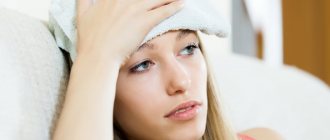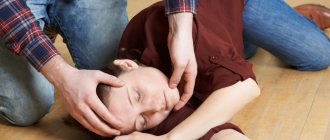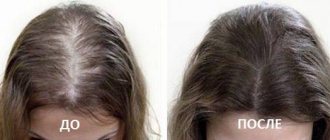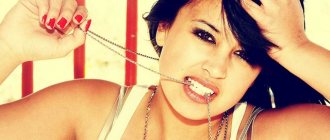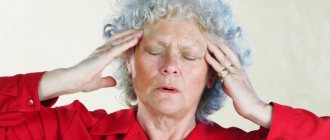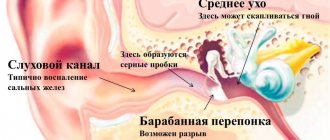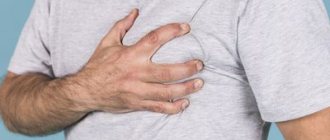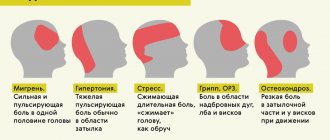If you suffer from headaches of unknown origin, you should consult a doctor to find out the cause. Self-medication in this case will do more harm than good. If you know for sure that you are experiencing tension pain, you can help yourself by mastering several head massage techniques.
Many people read the body's needs intuitively, without any special knowledge. By stroking a crying child's head, we calm the baby and relieve anxiety, and rubbing the temporal area in order to increase concentration actually gives a certain result. Based on this, we can draw a simple conclusion: competent influence on certain points leads to an improvement in the general condition, and this should be used!
Headache in one point when pressing. Cluster pain
A rare pathological condition that occurs predominantly in men and is characterized by painful headaches. The causes and mechanism of development of the disease are not fully understood. Patients note its sudden development; in rare cases, the attack begins with nasal congestion. The pain is localized in the parietal part of the head, radiating to the temple or eye area. There seems to be pressure on the skull from above, usually from one side. The sensations are sharp and burning, and can be boring. Accompanied by lacrimation, redness of the eyes, sweating of the face. Attacks last from 15 minutes to 1.5 hours and are repeated several times a day for 1-3 months.
You can learn more about cluster pain here.
A neurological disease of unknown etiology most often causes discomfort in women.
The headache appears from the top center and gradually covers one half of the skull. Symmetry of the symptom is rare. Sensations appear suddenly or after precursors - an aura. They are intense, similar to pulsation, radiate to the eye, temple or back of the head, and last from 2-3 hours to 3 days. Often the attack is accompanied by nausea and vomiting, which brings relief. The clinical picture intensifies under the influence of pungent odors, loud sounds, and bright light.
Where are cryodynamics services provided?
Anyone can benefit from a cooling procedure for the area of the body where the feng fu point is located. Reviews about where it is located and what the impact of cryogenic procedures performed in cosmetology or medical centers are are basically positive. The reason for this is the complex effect on the body of several stimulating procedures. Facial skin rejuvenation becomes noticeable after just two weeks of regular visits.
The vast majority of people are not ready to visit salons every day, morning and evening. Men do not want to visit them by definition. The advantage of medical centers is that they use an integrated approach. But for this it is necessary to undergo a course of inpatient treatment. Not everyone has enough free time. And you will definitely have to spend a considerable amount of money on the procedures.
The first set of classes lasts a month. This is the key circumstance that has made the affordable home version of the technique very popular.
It is enough to have a refrigerator with a freezer, a sofa or a bed at home, and then you can begin to put the proposed method into practice yourself.
Pressure pain in the back of the head. For hypotension
Low blood pressure is often not the cause of headaches, but can act as a catalyst for pathological processes that affect well-being.
Abnormal circulation caused by hypotension sometimes leads to excess blood in the vessels, arterioles and small arteries of the head. The vessels dilate and there is excess blood flow, which stretches them. During the stretching process, throbbing pain occurs.
When the back of the head hurts, increased intracranial pressure is diagnosed, causing discomfort. Hypotension is not often the root cause of pain in the back of the head or head. Even in a few clinical cases, pain from the back of the head is rarely observed; more often, hypotension leads to discomfort in the temples.
The onset of pain due to hypertension in a hypotensive patient is predominantly noted, when, with normal blood pressure for a healthy person (120–130/80 mm Hg), a hypotensive patient experiences pain and other symptoms of high blood pressure.
This type of pain occurs due to decreased tone of the veins located inside the skull.
Pain can be triggered or increased by:
- a prolonged state of leaning forward, especially when the head is below the level of the heart;
- increased physical stress on the neck and shoulder blade area;
- prolonged lying.
Where is this point
Where the head ends and the neck begins is one of the most vulnerable places in the human body. Here there is direct open access to the brain, not covered by bone. This is a feng fu point. Finding it is very easy - use your index finger to feel the depression on the neck under the back of the head. This is an asymmetric acupuncture point - it does not have a pair. To have a clear idea of where the feng fu (point) is located, a photo with an exact indication of the location is located below the text.
Here are the nerve endings leading to the large occipital and suboccipital regions of the brain. This place is also the center of the small arterial circle, which supplies the brain with oxygen and other nutrients. It is formed by two large supply arteries that supply our brain. The exclusivity of this location lies in the fact that directly below it is the medulla oblongata of our body.
Headache in the forehead area. Diagnostics
Only a specialist can tell you exactly why your head hurts in the forehead area. Determining the cause is associated with an analysis of the nature of the pain and accompanying symptoms. Signs of a cold will be detected by a therapist or pediatrician by conducting a general examination and obtaining a blood test. This doctor will also suspect inflammation of various forms of sinusitis. However, only an otolaryngologist can make an accurate diagnosis based on an x-ray and blood test.
Most diseases that lead to pain in the head are diagnosed by a neurologist. To clarify the diagnosis, he prescribes the following studies:
- MRI. The resulting images make it possible to evaluate the structure of the brain, tissue density, the presence of tumors, necrosis, hematomas, the amount of cerebrospinal fluid, and the condition of blood vessels. Can be performed on young children and pregnant women. Children are performed under anesthesia.
- CT scan. As a result of the examination, a detailed picture is obtained that characterizes the presence of inflammation, tumors, and hemorrhages. Helps to see lesions of the sinuses, skull bones, and membranes of the brain.
- Angiography. It is a type of radiography with the introduction of a contrast agent.
- Ultrasound and Dopplerography of the brain and neck. Allows you to see organic lesions, identify disturbances in the shape, size of blood vessels, individual areas of the brain, and determine the speed of blood flow.
To confirm intracranial hypertension, consultation with an ophthalmologist is necessary. Also, in order to determine this diagnosis, a puncture of the cerebrospinal fluid is performed.
How to make a head massage more effective?
All remedies are good in the fight against hair loss, especially if the effectiveness of these remedies is confirmed by reputable experts. Using ALERANA® Hair Growth Serum will significantly increase the effectiveness of the massage and improve the overall condition of the hair and scalp.
A complex of components of plant origin increases blood circulation, improves nutrition of hair follicles and activates cellular metabolism. Regular massage procedures using serum prevent hair loss and premature aging of hair follicles.
Clinical researches
For an accurate diagnosis, contact a specialist.
Headache in the back of the head. Features and types of pain
Doctors identify several features of pain in the occipital region:
1. Primary, which is not related to diseases and appears in 90% of cases.
2. Secondary, which appears as a result of inflammation and occurs in 10% of cases. In approximately 4% of patients who complain of a headache in the back of the head, serious illnesses are found that can become a threat not only to their general condition, but also to life.
Pain in the back of the head can appear in different directions and most often it occurs on the left.
As a rule, discomfort is observed during head movements, and some patients think that the symptom appears not in the head, but in the cervical region, after prolonged work in a sitting position or severe fatigue.
There are several types of pain in the back of the head on the left side:
1. Acute. It begins as a result of emotional tension, stress and depression.
2. Stupid. Unpleasant sensations appear, the person cannot touch the head. A similar condition is typical for osteochondrosis and arthritis.
3. Aching. The back of the head hurts due to spasm in the shoulders or neck. Often occurs during severe mental stress.
4. Pulsating. Pain in the back of the head with high blood pressure and symptoms often appear in the morning. In addition, white spots appear in the eyes and tinnitus.
Regardless of its appearance, an occipital headache on the left causes a lot of discomfort; a person cannot concentrate and work normally.
If symptoms appear regularly, then a high-quality and complete diagnosis is necessary.
Painful point on the head. Primary point pain
One of the types of point cephalgia is primary head pain, the symptoms of which in most cases are typical and rarely appear in another form:
- acute pain manifests itself in the form of single or serial impulses, similar to an injection;
- the duration of spontaneously occurring attacks does not exceed a few seconds, while the time interval between them varies from several times a day to a month;
- the location of outbreaks of pain is the area of the temples, crown, frontal lobes and orbits;
- attacks of primary pain are not aggravated by symptoms that appear in other types of cephalalgia.
The causes of primary point pain must be considered individually.
Such pain in most cases is not associated with serious diseases, but can occur under the influence of external factors - unfavorable weather conditions, drinking cold drinks, fatigue or stress on the organs of hearing and vision. People suffering from histamine cephalalgia or migraine are also susceptible to point primary headaches. In this case, sharp impulses appear in the area of localization of migraine and cluster pain. Primary pain, which occurs rarely and in isolated cases, does not require drug treatment, since it does not inhibit the functioning of the body as a whole and does not reduce the quality of life. If a headache occurs in one point more often than usual, the patient, in consultation with the doctor, can take the following medications:
Is something bothering you? Illness or life situation?
Describe your problem to us, or share your life experience in treating the disease, or ask for advice! Tell us about yourself right here on the site. Your problem will not go unnoticed, and your experience will help someone!
- Painkillers. In most cases, this is Indomethacin, the positive effect of which is experienced by up to 65% of patients susceptible to primary point pain. To protect the gastric mucosa, gastroprotective drugs must be taken along with Indomethacin.
- Anti-inflammatory drugs whose actions are similar to Ibuprofen.
- Neurohormonal agent Melatonin, which normalizes brain activity, activates mental processes, memory, and thinking. Melatonin is prescribed by a doctor if Indomethacin is ineffective, taking into account multiple contraindications (for example, pregnancy) and side effects (emotional swings, weakness, nausea, dizziness, drowsiness).
My forehead hurts when I touch it. What to do if your forehead hurts and your temperature rises?
The most likely cause of pain in the forehead in combination with an increase in body temperature is an acute respiratory viral infection (influenza, parainfluenza). In addition, this symptomatology can also precede inflammation of the frontal paranasal sinuses (frontal sinusitis). It is worth noting, however, that in addition to the above reasons, these symptoms can also occur with many other pathologies. Treatment for each of these pathologies may differ significantly, and that is why it is important to consult a doctor in a timely manner to correctly diagnose the disease. In order to relieve pain, nonsteroidal anti-inflammatory drugs (NSAIDs), which have a moderate analgesic effect, are usually used. To reduce the severity of headaches, the following medications are most often used:
- paracetamol;
- aspirin;
- diclofenac;
- ibuprofen;
- naproxen.
Also, these medications can lower body temperature to a certain extent (eliminate fever and chills). This is achieved due to the fact that these medications are able to influence the thermoregulation center and increase the normal body temperature to a higher point. It is worth noting that children can be given only two drugs to reduce body temperature - paracetamol and ibuprofen. Unlike other representatives of this drug group (NSAIDs), these two drugs have virtually no side effects and are therefore relatively safe.
Area of responsibility of the medulla oblongata
In this zone, many of the most important processes that occur in our body are controlled without conscious human participation. Here are just some of the main ones:
- breath;
- swallowing;
- salivation;
- control of arterioles - blood pressure regulators;
It is characteristic that this important control center of the body works throughout the entire life of the body, continuing its activity during deep sleep and even during complete anesthesia.
Painful point on the left rib. Pain in the ribs
Rib pain usually refers to discomfort that occurs in the chest wall, rather than inside it. In this case, the source of discomfort is bone or cartilage tissue, adjacent muscles or nerves. Pain in the ribs can be of a different nature: it can be constant or intermittent, sudden or increasing, acute or dull. Doctors explain this diversity by a large number of underlying causes.
Pain in ribs when pressed
Sometimes an inflammatory process can occur in the cartilages that are attached to the sternum - Tietze syndrome. Pain in the ribs when pressed in this case can be quite intense and resemble symptoms of angina pectoris. In addition, attacks can occur spontaneously, without external influence. The localization of pain can be very diverse.
Tietze's disease is accompanied by additional symptoms:
- swelling in the area of the inflamed costal cartilage;
- when pressing or squeezing the sternum, the discomfort becomes stronger;
- the first attack may develop against the background of trauma.
In any case, if discomfort in the rib area bothers you for more than three days, you should definitely seek help from a doctor. But before you go to your appointment, you can undergo a self-diagnosis on our website. It contains a simple test, by answering the questions of which you can get a preliminary diagnosis and understand which specialist you need to make an appointment with.
Painful point on the foot. 21 points on the feet, massage of which improves well-being
- On our feet there are projection zones of many internal organs, by acting on which we can improve our well-being.
- It is recommended to massage the feet as a whole, rather than individual points. First, your feet need to be stretched and warmed up: walk barefoot, rise on your toes several times, take a warm foot bath.
- Rub the entire foot with stroking movements, then begin to press on each active point (3-7 seconds), moving from the toes to the heel. Also use techniques such as pulling (when massaging your fingers), tapping (with the edge of your palm), pinching, and kneading.
- In the process, you may discover pain points. This means that the organs for which they are responsible are not in order. These points need to be massaged with special care.
- The technique of influencing painful areas is pressure (with the thumb), which must be alternated with pauses, and the whole process should take at least a minute. The result of a properly performed massage is the disappearance of pain.
- The following contraindications exist for foot massage: high temperature, impaired blood clotting, exacerbation of chronic diseases, deep scratches or injuries on the surface of the feet.
Bright Side will show you the most important points and tell you how to massage them to always feel 100%.
Massage for headache points. Sequencing
General acupressure for headaches involves working each area through acupuncture points in the following sequence: frontal zone, temporal, parietal and occipital. Allow 2 minutes to massage each zone. The entire procedure takes 8–10 minutes.
The massage is performed in a sitting position for the convenience of the procedure. Let's look at the massage therapist's movements step by step
1. Frontal, temporal areas:
- strokes are performed with palms from left to right, in the opposite direction;
- stroking is replaced by light pressure with the palm, the brush is pressed and slowly moved from the right area of the forehead to the left, the “third eye” in the central part of the forehead is massaged for a few seconds, and the movement continues to the left; the exercise is repeated in the opposite direction;
- do light stroking and repeated pressure;
- knead with vertically placed fingers, the index finger is placed at the hairline, the little finger at the outer edge of the eyebrow;
- kneading is repeated with great effort so that the subcutaneous tissue moves along with the fingers.
2. Parietal region:
- perform stroking, as if combing hair in the forehead-back of head direction, repeat the actions 3-4 times;
- light stroking is replaced with intense kneading, the direction of movements is unchanged: forehead-parietal area-occiput, the skin moves with the fingertips during movements;
- complement the impact with vibration, the movements resemble intermittent (jumping) shaking, the fingers are spread wider, with their pads resting on the skin;
- perform quick taps with palms;
- The palms are placed symmetrically above the ears, with massage movements they are gradually brought closer together, the procedure is repeated, changing the location of the palms (the right one is placed on the back of the head, the left one on the forehead).
3.
Back of the head:
- perform stroking and kneading, similar to the frontal area;
- start working on the lower part of the back of the head, massaging the neck muscles, they are often overstrained and contribute to the appearance of painful sensations;
- acupuncture points of the lower part of the back of the head are worked out, pressure is applied to the dimples, located 3–4 cm below the center of the base of the skull; The first pressure is painful, then the discomfort goes away.
If the movements are performed correctly, influencing the desired active points, the patient feels a slight tingling, numbness of the skin, goosebumps appear, and warmth and lightness are felt in the acupuncture area.
Painful point on the abdomen. Pain points in the head and neck area
- pain points of exit of the I, II, III branches of the trigeminal nerve - with neuralgia of this nerve, sinusitis, meningism and meningitis, arachnoiditis (absent in comas);
- Greenstein's vascular pain points: at the inner corner of the orbit - with phlebitis and thrombophlebitis of the facial veins; behind the ears in the area of the tubercles of the occipital bone - with vasomotor pathologies of cerebral vessels, meningitis;
- pain points in the temple area above the zygomatic process - with arteritis and sympathalgia of the face, leptomeningitis;
- pain points in the area of the mastoid process, in front and downward from the tragus of the ear - with neuritis and neuralgia of the facial nerve, otitis, mastoiditis;
- pain points at the base of the skull above the first cervical vertebra at the exit point of the occipital nerves - with neuralgia of these nerves, cervical osteochondrosis, meningitis, tumors of the cerebellopontine zone;
- pain points of the spinous processes of the cervical vertebrae, intervertebral discs, paravertebral - for osteochondrosis, herniated intervertebral discs;
- pain points of the vertebral artery on the line connecting the apexes of the mastoid process and the spinous process of the second cervical vertebra - with pathology of the vertebral artery and cardialgia of various origins.
Acupuncture
A traditional method of influencing acupuncture points of the human body is acupuncture. In the place where the feng fu point is located, there is a thick, dense layer of fat, which compensates for the lack of bone for protective purposes. Therefore, long needles are used for the procedure, which are inserted to a depth of one centimeter.
In China, it was customary to simultaneously apply cauterization and needles, which increased the effect and contributed to a faster response of the body to the stimulus.
